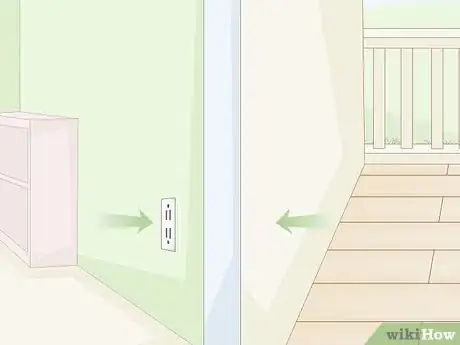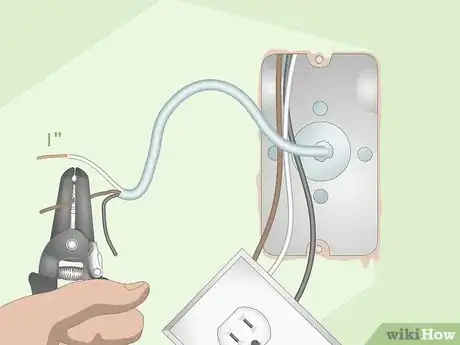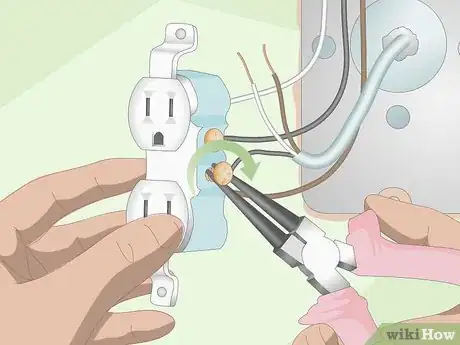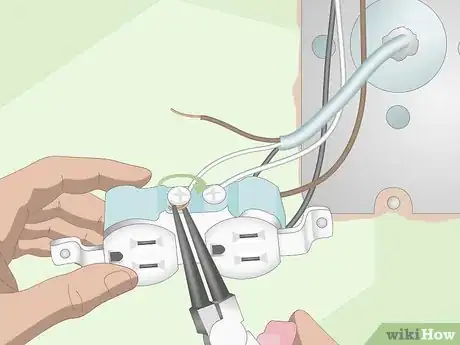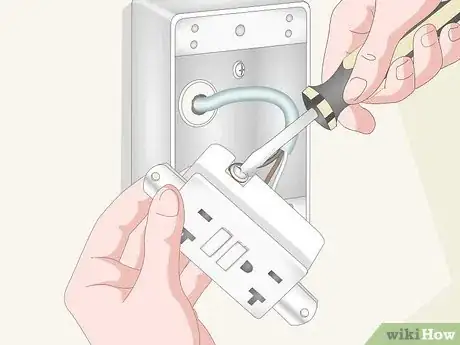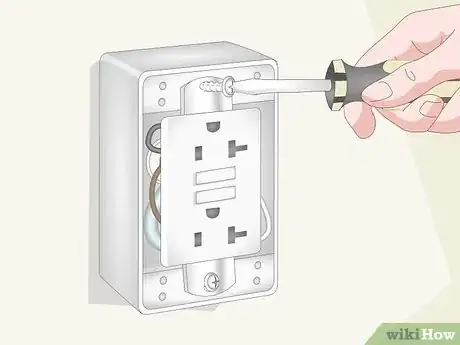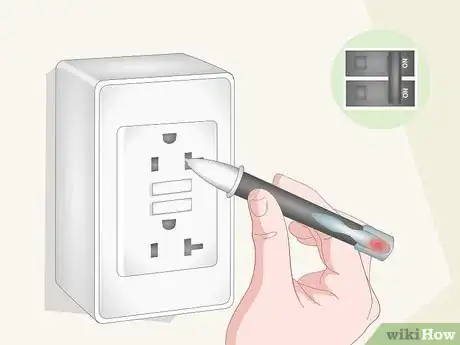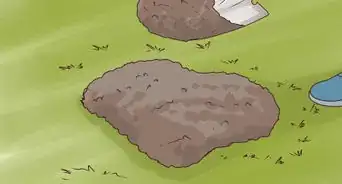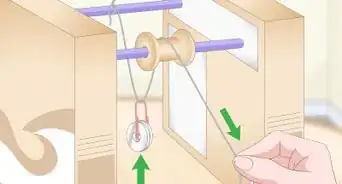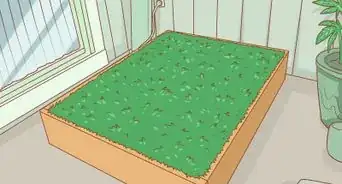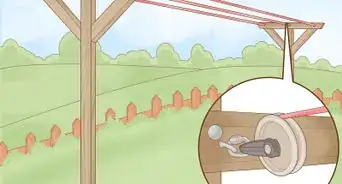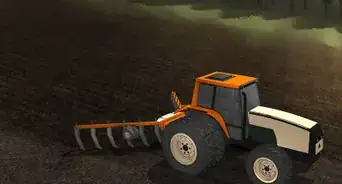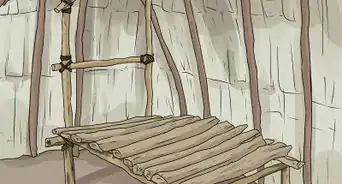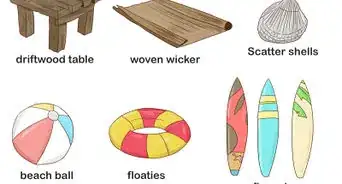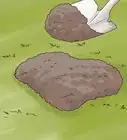This article was co-authored by Ricardo Mitchell and by wikiHow staff writer, Hunter Rising. Ricardo Mitchell is the CEO of CN Coterie, a fully licensed and insured Lead EPA (Environmental Protection Agency) Certified construction company located in Manhattan, New York. CN Coterie specializes in full home renovation, electrical, plumbing, carpentry, cabinetry, furniture restoration, OATH/ECB (Office of Administrative Trials and Hearings/Environmental Control Board) violations removal, and DOB (Department of Buildings) violations removal. Ricardo has over 10 years of electrical and construction experience and his partners have over 30 years of relevant experience.
There are 13 references cited in this article, which can be found at the bottom of the page.
This article has been viewed 52,020 times.
Exterior outlets are a great addition to your home if you want to have the option to plug something in outside. Luckily, installing an outlet outdoors requires minimal wiring so you can easily do it in an afternoon. Line up the new exterior outlet with one that you already have inside so you can connect power between them. Once you find a spot for your outlet, drill through your walls so you can run the wires outside. With a little bit of work, you'll be able to power anything you need outdoors!
Steps
Placing and Drilling the Holes
-
1Find an indoor receptacle to connect to on the wall where you want the exterior outlet. Look around the outside of your home for an area where you want to place the outlet, such as on a porch or patio. Once you find the spot where you want to place the outlet, go inside your home and find the nearest outlet on the other side of the exterior wall. Be sure to choose an outlet that isn't switch-operated or else the exterior outlet won't work when you plug into it.[1]
- If you don't have an inside outlet on the wall where you want the exterior outlet, then hire an electrician to run wires from your circuit box to the spot.
- Rather than connecting to an existing receptacle, you can also run the outlet back to your circuit breaker.[2]
-
2Turn off the power at the circuit box for the outlet that you're connecting to. Locate the breaker inside your circuit box that controls the interior outlet and flip the switch to the off position. Put an outlet tester in the plug to see if it still has a current running through it. If none of the lights turn on when you plug the tester in, then it's disconnected from power and you can continue working.[3]
- Try the outlet tester in a plug that you know works to make sure the tester functions properly.
- Never work on an outlet when it's still connected to power since you could electrocute yourself.
- If some of the lights still turn on when you plug the tester in, then the outlet is still live and you turned off the wrong breaker. Continue testing the breakers until the tester says the outlet has no power.
Variation: You can also use a multimeter to test the voltage of your outlet. Push the black probe into one of the vertical slots on your outlet and the red probe in the other. If the voltage is 0, then the power is disconnected.
Advertisement -
3Remove the outlet from the wall to access the box behind it. Use a screwdriver to remove the cover plate on the outlet and set it aside. Unscrew the screws on the top and bottom of the outlet to loosen it from the wall. Once you remove the screws from the outlet, carefully pull it out from the wall so the wires stay attached to it.[4]
- Keep the screws for your outlet in a small container so you don't misplace them while you're working.
-
4Drill straight through the back of the outlet box and siding. Position the end of a 12 in (30 cm) drill bit through the hole at the back of the outlet box, making sure it doesn't touch any wires. Turn the drill on and slowly push through the wall behind the outlet box. Continue pushing the drill bit through the wall until you feel it pop out through the exterior wall and through your siding.[5]
- If you can't drill through the back of the outlet box, then drill the hole next to the top corner of the box so you can still easily access the wires.
- If the inside outlet is less than 1 foot (30 cm) from the ground, angle your drill bit up so it comes out higher on the exterior wall. Never place an exterior outlet less than 1 foot (30 cm) from the ground since it could easily be exposed to moisture.
- If you're drilling through concrete or brick, use a drill bit meant for masonry.
-
5Feed a 12/2 cable through the hole in your outlet box. A 12/2 cable contains a live, neutral, and ground wire inside so you can easily attach an outlet to it. Push the 12/2 cable through the hole you just drilled so there's 5 inches (13 cm) of excess on the inside and outside of your home. Cut the cable to size with a pair of wire cutters.
- You can buy 12/2 cables from your local hardware store.
Connecting the Wires to the Power
-
1Strip 3–4 in (7.6–10.2 cm) off the interior end of the 12/2 cable. Clamp the jaws of a 12/2 cable stripper 3–4 inches (7.6–10.2 cm) from the end of the cable and squeeze the handles together. Pull the stripper toward the end of the cable to cut through the insulation and expose the 3 wires inside. Pull any leftover insulation off the 12/2 cable if it doesn't come off with the stripper.[6]
- You can get a 12/2 stripper from your local hardware store.
Tip: If you don't have a 12/2 stripper, carefully slice down the middle of the cable with a utility knife and peel the insulation back.
-
2Expose 1 in (2.5 cm) on the end of each wire inside the 12/2 cable. The 12/2 cable contains a black wire, a white wire, and an exposed copper wire. Grip the black wire 1 inch (2.5 cm) from the end with a pair of wire strippers and pull them toward you to remove the insulation. Repeat the process on the white wire so you can attach them to the outlet.[7]
- Sometimes, the ground wire may have green insulation around it. If there's a green wire in the cable, strip it as well.
-
3Loop the black wire clockwise around the live screw on the outlet. Use a pair of needlenose pliers to bend the end of the black wire into a loop. Locate the black screw on the side of the outlet and position the loop you made underneath the screw head. Make sure the loop goes clockwise around the screw so it has a full connection. Tighten the black screw to secure the live wire in place.[8]
- Check the back of your interior outlet to see if it has ports where you can plug additional wires in. That way, you don't need to loop the wire around the screw but it will still get power.
-
4Secure the white wire around the silver neutral screw. Bend the end of the white wire into a small circle with a pair of needlenose pliers. Loop the wire around the silver screw on the opposite side of the outlet so it goes clockwise. Tighten the screw with a screwdriver to secure the wire in place.[9]
- Put the wire in the back of the outlet behind the silver screw if there's a port so you don't have to wrap it around the screw.
-
5Wrap the ground wire from the 12/2 cable around the one attached to the outlet. Straighten the end of the exposed copper wire from the 12/2 line with your pair of pliers and line it up with the ground wire connected to the top or bottom of the outlet. Twist the wire from the 12/2 cable around the ground wire on the outlet by hand so it has a secure connection.[10]
- If the ground wire attached to the outlet has insulation around it, then wrap the end of the ground wire around the screw on the top or bottom of the outlet.
-
6Secure the interior outlet back in place. Push the outlet and wires back into the outlet box inside your wall. Line up the screws on the top and bottom of the outlet and secure them in place with your screwdriver. Put the cover over the outlet and screw it back in so all the wires are inside your wall.[11]
- Don't turn on your breaker for the outlet yet since the wires on the other side of the 12/2 cable are still exposed.
Attaching the Exterior Outlet
-
1Screw an exterior outlet box to the outside wall so it lines up with the hole. Be sure to get an outlet box that's meant for exterior use. Guide the end of the 12/2 cable through the hole in the middle of the exterior box and push the box against your siding. Locate the screw holes in the back of the box and drive screws into your siding to secure it tightly in place.[12]
- You can buy exterior outlet boxes from your local hardware or home improvement store.
- If you have brick exterior walls, position the screws so they go through the middle of the bricks rather than through the mortar.
Tip: If you have concrete or brick exterior walls, be sure to use masonry anchors so they don't fall out.
-
2Buy a GFCI outlet that's approved for outdoor use. GFCI outlets have a failsafe on them so they immediately stop working when they get wet. Look for a GFCI outlet that's rated for outdoor use or else it may not be safe to use. Make sure that the outlet fits inside the exterior box you attached to the wall so it's protected from the elements.[13]
- You can buy GFCI outlets from your local hardware store.
-
3Strip 3–4 inches (7.6–10.2 cm) off the end of the 12/2 cable to expose the wires inside. Clamp your 12/2 stripper so it's 3–4 inches (7.6–10.2 cm) from the end of the cable. Pull the stripper toward the end of the cable to remove the outer insulation around the 3 wires inside it. Pull the wires apart to separate them so they're easier to work with.[14]
- You can also slice down the middle of the 12/2 cable with a utility knife and peel back the insulation to expose the wires.
-
4Remove 1–2 in (2.5–5.1 cm) of insulation from the live and neutral wires. Grip the black wire 1 inch (2.5 cm) from the end with a pair of wire strippers. Pull the stripper toward the end of the wire to remove the insulation and expose the copper wire inside. Repeat the process with the white wire so you can attach it to the neutral screw.[15]
- Remove the green insulation from the ground wire if it has it.
-
5Attach each of the wires to their corresponding screws. Wrap the end of the black wire around the black screw and the white wire on the silver screw. Attach the end of the copper ground wire to the green screw that's either on the top or bottom of the outlet. Make sure the loops go around the screws clockwise so the current can travel at full strength. Once all the wires are attached, tighten all of the screws so they have a secure connection.[16]
- Your outlet may have ports on the back where you can plug the wires in rather than wrapping them around the screws.
-
6Screw the outlet into the exterior box to hold it in place. Hold the outlet inside of the exterior box so the screwholes line up with one another and so the wires are tucked in the back of the box. Use either wood screws or masonry anchors depending on whether you have wood or concrete exterior walls. Tighten the screws on the outlet to the sides of the box so it's secured in place.
- Some exterior boxes allow you to screw the outlets directly into them so you don't need to put more screws in your siding.
-
7Turn on the power to the outlet to test if it works. Flip the switch on your circuit box so your outlets have power again. Plug your outlet tester into the indoor and outdoor outlets to see if they're working. Check the key on top the tester to determine if the wiring for your outlets are correct.
- If the outlets still aren't working or the tester shows the wiring is wrong, turn off the circuit again and check the wires.
Expert Q&A
-
QuestionDo outdoor outlets need to be on their own circuit?
 Ricardo MitchellRicardo Mitchell is the CEO of CN Coterie, a fully licensed and insured Lead EPA (Environmental Protection Agency) Certified construction company located in Manhattan, New York. CN Coterie specializes in full home renovation, electrical, plumbing, carpentry, cabinetry, furniture restoration, OATH/ECB (Office of Administrative Trials and Hearings/Environmental Control Board) violations removal, and DOB (Department of Buildings) violations removal. Ricardo has over 10 years of electrical and construction experience and his partners have over 30 years of relevant experience.
Ricardo MitchellRicardo Mitchell is the CEO of CN Coterie, a fully licensed and insured Lead EPA (Environmental Protection Agency) Certified construction company located in Manhattan, New York. CN Coterie specializes in full home renovation, electrical, plumbing, carpentry, cabinetry, furniture restoration, OATH/ECB (Office of Administrative Trials and Hearings/Environmental Control Board) violations removal, and DOB (Department of Buildings) violations removal. Ricardo has over 10 years of electrical and construction experience and his partners have over 30 years of relevant experience.
Electrician & Construction Professional, CN Coterie Since existing outlets already have their load maximums calculated, you'll run into less trouble if you install outdoor outlets on their own circuits.
Since existing outlets already have their load maximums calculated, you'll run into less trouble if you install outdoor outlets on their own circuits.
Warnings
- Never work on electrical wires while the power is still on since you could shock or electrocute yourself.⧼thumbs_response⧽
- Always wear safety glasses while you're working with power tools so you don't get anything in your eyes.⧼thumbs_response⧽
- If you don't feel comfortable wiring the outlet yourself, call a professional electrician to do the work for you.⧼thumbs_response⧽
Things You'll Need
- Outlet tester
- Screwdriver
- Safety glasses
- Drill with a 12 in (30 cm) bit
- 12/2 cable
- 12/2 cable stripper
- Wire stripper
- Needlenose pliers
- Exterior outlet box
- GFCI outlet made for outdoor use
References
- ↑ https://youtu.be/4pyDGAzWKus?t=50
- ↑ Ricardo Mitchell. Electrician & Construction Professional, CN Coterie. Expert Interview. 6 May 2020.
- ↑ http://blog.rismedia.com/2018/adding-insulating-outdoor-receptacle/
- ↑ https://youtu.be/4pyDGAzWKus?t=99
- ↑ https://youtu.be/4pyDGAzWKus?t=301
- ↑ https://youtu.be/bo15p4OaH70?t=13
- ↑ https://youtu.be/bo15p4OaH70?t=164
- ↑ https://youtu.be/4pyDGAzWKus?t=642
- ↑ https://youtu.be/4pyDGAzWKus?t=642
